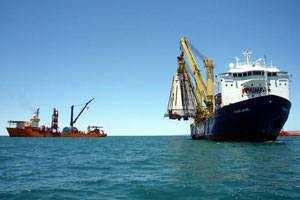MV Fairlane Completes Heavy Lift Project
In the Exmouth sub-basin, offshore Northwest Australia, Apache Energy ltd. is developing the Van Gogh oilfield on behalf of a joint venture of the same name. As part of the Vincent field, it lies in water depths of 1,115.5 to 1,214 ft.
An FPSO will be used for production and storage of the oil. The FPSO will be moored to a disconnectable turret-mooring (DTM) buoy, moored to the seabed with nine anchors. Flexible flowlines, which connect to two subsea manifolds and the production wellheads, will be attached to the buoy. In the event of storms or cyclones, the FPSO will be able to disconnect from the buoy and sail to calmer waters.
The offshore installation contractor for the Van Gogh project, Acergy Australia pty ltd., asked Jumbo to take care of the transportation of the massive DTM buoy from Singapore to the Exmouth gulf, delivering sub-sea equipment to the subsea installation vessel mv Toisa Proteus, and demobilizing equipment from the Toisa Proteus to Singapore.
Beside the normal engineering procedure, additional planning was required in the preparation phase of the project. Lifting the DTM buoy was only possible from the top, using a single point connection. A special lifting device to suspend the ball tool was designed in-house and manufactured under supervision of Jumbo in Singapore. A special grillage was designed to support and sea-fasten the buoy. Extensive motion analyses together with finite element calculations were carried out to determine the loads exerted by the buoy on the main deck, caused by accelerations in rough seas.
Halfway October 2008, Jumbo’s MV Fairlane arrived in Singapore to load the 500 tons DTM buoy. The grillage was placed on the main deck hatch covers of the vessel, and the special lifting gear prepared. Another grillage was installed to be able to store the assembled lifting gear next to the buoy. A barge carrying the DTM Buoy was maneuvered alongside. The ball tool male connector was lowered into the female receptacle on top of the buoy. Once inserted, the hydraulic pressure was taken of, and the connection was fixed. The Fairlane’s two 400 tons mast cranes then slowly lifted the buoy on deck, using almost all the available lifting height.
After the buoy was thoroughly sea fastened, MV Fairlane sailed to Dampier, to wait for suitable conditions, and for the other involved vessels to arrive in de Exmouth Gulf. A few days later, the heavy lift vessel met the Toisa Proteus and two anchor handling tugs (AHT’s) in the Exmouth gulf at the end of October. After the final joint preparations, the ball connector was again lowered into the top of the DTM buoy, while one AHT was already connected with a long polyester line. The Fairlane discharged the buoy into the water, while it was automatically ballasted. The water system of the Fairlane was used to ballast four J-tubes inside the buoy for additional stability. The other AHT was also connected to the buoy, and when the stability and draft of the buoy were correct, the ball connector was disconnected and retrieved. The buoy could be towed to its final destination offshore.
Subsequently, the Fairlane sailed to the port of Henderson, near Perth, for the next phase of the project. Two subsea manifolds of respectively 160 and 180 tons, four riser bases of 100 tons, and some smaller items were loaded. After returning to the gulf of Exmouth, the Fairlane moored alongside MV Toisa Proteus, and lifted the subsea equipment onto the main deck of the construction vessel. Jumbo’s heavy lift vessel completed the challenging project by demobilizing other equipment from the Toisa Proteus to Singapore on December 3. First oil from the Van Gogh field is expected march 2009.
(www.jumboshipping.nl)











